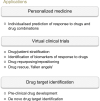Predictive Modeling of Drug Treatment in the Area of Personalized Medicine
- PMID: 26692759
- PMCID: PMC4671548
- DOI: 10.4137/CIN.S1933
Predictive Modeling of Drug Treatment in the Area of Personalized Medicine
Abstract
Despite a growing body of knowledge on the mechanisms underlying the onset and progression of cancer, treatment success rates in oncology are at best modest. Current approaches use statistical methods that fail to embrace the inherent and expansive complexity of the tumor/patient/drug interaction. Computational modeling, in particular mechanistic modeling, has the power to resolve this complexity. Using fundamental knowledge on the interactions occurring between the components of a complex biological system, large-scale in silico models with predictive capabilities can be generated. Here, we describe how mechanistic virtual patient models, based on systematic molecular characterization of patients and their diseases, have the potential to shift the theranostic paradigm for oncology, both in the fields of personalized medicine and targeted drug development. In particular, we highlight the mechanistic modeling platform ModCell™ for individualized prediction of patient responses to treatment, emphasizing modeling techniques and avenues of application.
Keywords: cancer; drug development; mechanistic models; ordinary differential equations; virtual clinical trials; virtual patient models.
© 2015 the author(s), publisher and licensee Libertas Academica Ltd.
Figures


Similar articles
-
Models of Models: A Translational Route for Cancer Treatment and Drug Development.Front Oncol. 2017 Sep 19;7:219. doi: 10.3389/fonc.2017.00219. eCollection 2017. Front Oncol. 2017. PMID: 28971064 Free PMC article.
-
From integrative disease modeling to predictive, preventive, personalized and participatory (P4) medicine.EPMA J. 2013 Nov 6;4(1):23. doi: 10.1186/1878-5085-4-23. EPMA J. 2013. PMID: 24195840 Free PMC article.
-
Personalizing oncology treatments by predicting drug efficacy, side-effects, and improved therapy: mathematics, statistics, and their integration.Wiley Interdiscip Rev Syst Biol Med. 2014 May-Jun;6(3):239-53. doi: 10.1002/wsbm.1263. Epub 2014 Mar 6. Wiley Interdiscip Rev Syst Biol Med. 2014. PMID: 24604755 Review.
-
Engineering Patient-on-a-Chip Models for Personalized Cancer Medicine.Adv Exp Med Biol. 2020;1230:43-64. doi: 10.1007/978-3-030-36588-2_4. Adv Exp Med Biol. 2020. PMID: 32285364 Review.
-
Respiratory healthcare by design: Computational approaches bringing respiratory precision and personalised medicine closer to bedside.Morphologie. 2019 Dec;103(343):194-202. doi: 10.1016/j.morpho.2019.10.042. Epub 2019 Nov 8. Morphologie. 2019. PMID: 31711740
Cited by
-
Models of Models: A Translational Route for Cancer Treatment and Drug Development.Front Oncol. 2017 Sep 19;7:219. doi: 10.3389/fonc.2017.00219. eCollection 2017. Front Oncol. 2017. PMID: 28971064 Free PMC article.
-
Differential Splicing of Skipped Exons Predicts Drug Response in Cancer Cell Lines.Genomics Proteomics Bioinformatics. 2021 Dec;19(6):901-912. doi: 10.1016/j.gpb.2019.08.003. Epub 2021 Mar 2. Genomics Proteomics Bioinformatics. 2021. PMID: 33662622 Free PMC article.
-
Translational Research in the Era of Precision Medicine: Where We Are and Where We Will Go.J Pers Med. 2021 Mar 18;11(3):216. doi: 10.3390/jpm11030216. J Pers Med. 2021. PMID: 33803592 Free PMC article. Review.
-
Efficient parameterization of large-scale dynamic models based on relative measurements.Bioinformatics. 2020 Jan 15;36(2):594-602. doi: 10.1093/bioinformatics/btz581. Bioinformatics. 2020. PMID: 31347657 Free PMC article.
-
Omics approaches to individual variation: modeling networks and the virtual patient.Dialogues Clin Neurosci. 2016 Sep;18(3):253-265. doi: 10.31887/DCNS.2016.18.3/hlehrach. Dialogues Clin Neurosci. 2016. PMID: 27757060 Free PMC article.
References
-
- Stewart Bernard W, Wild Christopher P., editors. World Cancer Report 2014.
-
- Dawson MA, Kouzarides T. Cancer epigenetics: from mechanism to therapy. Cell. 2012;150(1):12–27. - PubMed
LinkOut - more resources
Full Text Sources

